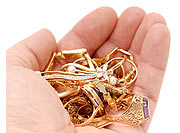I had problems figuring out what you guys meant. The formulas are in fluid ounces, not weight ounces. There are 29.6 mL in a fluid ounce. I just copied it off the instructions. Please not that I have never mixed these up. I always used the various pre-mixed solutions that I bought from companies that sell jeweler's supplies. I also see them on eBay. They also have 22KT. They're cheap.
If you can measure mL, milliliters, that would be the easiest. Here are the exact numbers. You can probably round them off. Just measure them as accurately as you can. Fluid ozs. don't convert to mL that evenly.
10KT - 22.2 mL nitric - 7.4 mL distilled water
14KT - 23.7 mL nitric - 5.9 mL distilled water - 10 drops hydrochloric
18KT - 5.9 mL nitric - 5.9mL distilled water - 17.8 mL hydrochloric
Silver - 20 grams potassium dichromate - 22.2 mL nitric - 7.4 ml distilled water





